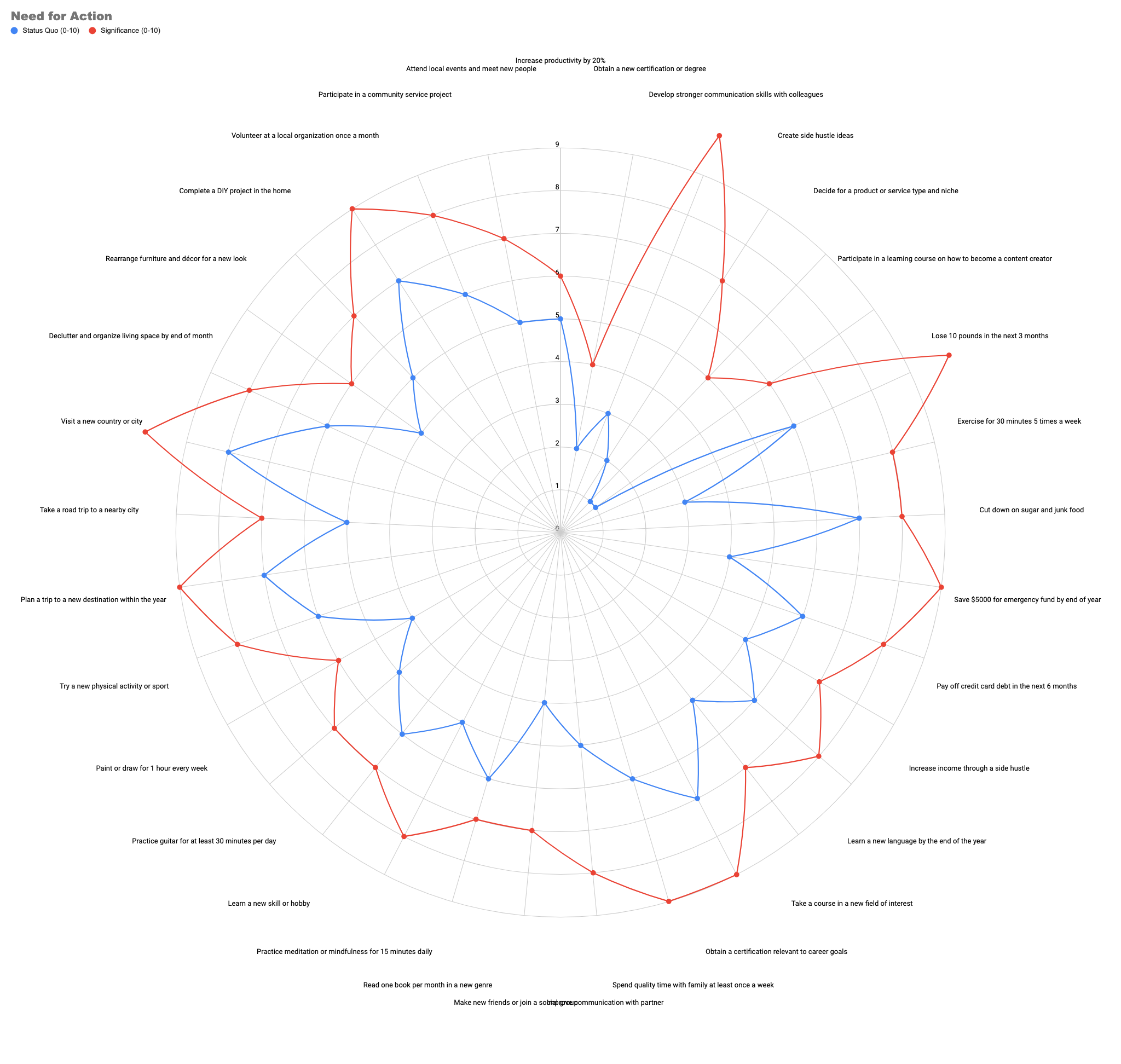Finding Balance in Life: How to Use a Spider Web Diagram to Identify Your Priorities
Learn how to identify your priorities and achieve balance in your life using a spider web diagram. Life is full of choices, and using this simple tool can help you visualize and prioritize different aspects of your life, from your career to your relationships, health, and hobbies.

Everyone should free up some high-quality time for their own agenda
A core concept of the Deliberate Diligence Mental Model is to trade low-quality evening time (entertainment, nighttime procrastination) for high-quality morning time.
It's easier for one person (single) and more complicated for another (family responsibilities). Still, everyone can do something to free up some time where you can invest a lot of mental and physical energy even before you go to your 9-5 job.
But there is one crucial question that needs to be answered:
What's the point of creating this high-quality time?
I bet that if you follow Deliberate Diligence, you already have more or less a concrete need for action in mind, or at least know in the abstract that you want/must change something or yourself.
But this also raises the question of priorities. I bet you have more plans than you have time for.
For me, it's like this: I have about 3 hours a day to invest in my personal agenda. That sounds like a lot, but in reality, I have different priorities fighting for that time:
- Workouts, endurance sports and walks for my health.
- The desire to build a side hustle with Deliberate Diligence.
- Deadlines in my corporate job that require extra work
- The wife who also wants my attention in the evenings
For the past few months, I have not been consciously managing my priorities, and then this is what happened: The latest venture (Deliberate Diligence) has displaced sport. Not entirely, but definitely in such a way that I suddenly put on weight again.
Of course, that's unpleasant and results from not controlling your priorities.
If you want to be more specific about your priorities, a spider web diagram is just what you need.
Life is full of choices, and sometimes it can be overwhelming to balance all the different aspects of our lives. From our careers to our relationships, our health to our hobbies, it can be difficult to determine our priorities and how to allocate our time and energy effectively.
However, using a simple tool known as a spider web diagram, we can easily visualise and prioritise the different areas of our lives, helping us find balance and achieve our goals.
What is a Spider Web Diagram?
A spider web diagram is a simple yet effective tool for organising and prioritising the different aspects of our lives. It consists of a central circle representing our core values, with lines radiating outwards to represent the areas of our lives. Each line can be labelled with a specific aspect of our life, such as our career, relationships, health, or hobbies.

By drawing a spider web diagram, we can easily see the interconnectedness of our different life areas and how they all impact one another. This can help us identify which areas of our life are most important and where to focus our attention and energy.
The easiest way to create Spider Web Diagram is on paper.
Using a spider web diagram is simple. All you need is a piece of paper and a pen.
- Start by drawing a large circle in the centre of the page, representing your core values.
- Next, draw lines radiating outwards from the centre circle, representing the different areas of your life. Label each line with a specific aspect of your life, such as your career, relationships, health, or hobbies.
- Once you have all your lines drawn, complete each section with more detail. Consider what is most important to you and what you hope to achieve in each area of your life.
- Finally, look at your diagram and consider the interconnections between the different areas of your life. Think about how your career impacts your relationships, or your health affects your hobbies.
Using this tool, you can quickly identify your priorities and find a balance that works for you.
You can also make the spider web diagram in Excel or Google Sheets.
If you prefer a digital solution, you can do it in Excel or Google Sheets. I have prepared a template for you to copy into your Google Sheets.

I have prepared the most straightforward priority calculation logic for you here. You are also welcome to change it and use more complex logic.
But this is how it works in the template:
- Step 1: Think about your life areas.
- Step 2: Brainstorm the goals you have for each Life Area.
- Step 3: You rate the importance in the column "Significance" on a scale from 0 to 10. The higher, the more critical.
- Step 4: You consider which topics you have already made progress on (column "Status Quo").
- Step 5: The priority is then automatically calculated according to the row where the need for action is greatest (significance - status quo).
If you have many projects, the priority column and the visualisation of the spider's web diagram should help you (scroll below the table in the sheet) recognise the critical issues.
Let's be honest: There can only be one priority at any given time. What is the most critical issue on your list? Is there anything that clearly stands out?
Otherwise, I would say that in addition to the main goal, you can perhaps seriously pursue 3-4 other goals. All the others are more for the back of your mind that you also want to do something there.

Benefits of a Spider Web Diagram
There are many benefits to using a spider web diagram to identify your priorities in life. Some of the key benefits include:
- Clarity: By visualising the different areas of your life, you can gain clarity on what is most important to you and where you want to focus your attention and energy.
- Balance: By considering the interconnections between the different areas of your life, you can find balance and ensure that you are not neglecting any area at the expense of another.
- Goal setting: By identifying what you hope to achieve in each area of your life, you can set clear and achievable goals that will help you move closer to finding balance and fulfilment.
- Focus: By clearly understanding your priorities, you can focus your attention and energy on the things that matter most rather than wasting time and energy on less important tasks.
Conclusion
In conclusion, everyone needs to free up some high-quality time for their personal agenda. The Deliberate Diligence Mental Model emphasises the importance of trading low-quality evenings/nights for high-quality morning time. While it may be easier for some than others, everyone can do something to create this time.
However, it is crucial to determine the purpose of this high-quality time and prioritise goals accordingly. Using tools such as a spider web diagram, you can gain clarity, balance, and focus and set achievable goals that will help you move closer to finding balance and fulfilment in your lives.
With the ability to visualise and prioritise the different aspects of our lives, we can find a balance that works for us, focus on what matters most, and achieve our goals.
Feel free to add tips and thoughts to this page's comment section, Twitter or LinkedIn!
Best regards,
-- Martin from Deliberate-Diligence.com

Discussion